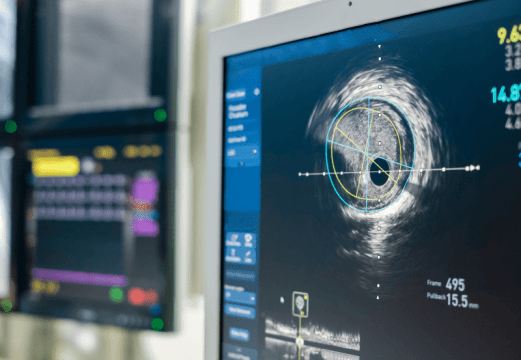Complementary imaging allows for the identification of numerous scenarios not visible with conventional angiography (ICA), both for the assessment of differential diagnoses and the improvement of percutaneous coronary intervention (PCI) outcomes. Advantages include assessment of plaque characteristics, vessel plaque burden, stent edge dissection, vessel diameter, and correct apposition, among others. While intravascular ultrasound (IVUS) was…
Use of Intravascular Lithotripsy in Left Main
The Left main coronary artery supplies circulation to roughly 70% of myocardium, and left main disease requires a high risk intervention with significant impact on patient prognosis. The current guidelines have set the threshold for intervention in LM disease at ≥50% stenosis, irrespective of the presence of symptoms or ischemic burden. LM calcification is an…
Edge-to-Edge Repair in Cardiogenic Shock
The edge-to-edge approach with MitraClip has been established as a valid strategy for patients who experience severe symptomatic mitral regurgitation (MI) with high risk for surgery, currently with a IIa indication. MI complicated by cardiogenic shock, which results in a high risk for conventional valve surgery, is a particularly complex scenario. In such a case,…
Should We Use Ultrasound Routinely to Guide Transfemoral Access?
Currently, transfemoral access (TFA) is used in large-caliber procedures and when transradial access fails. The introduction of ultrasound (US) to guide access has emerged as a technique that allows for precise channeling, avoiding accesses above or below the inguinal ligament. However, evidence regarding the use of this tool has shown diverse results. Two surveys conducted…
Recurrent Revascularization at 10 Years after Percutaneous Treatment of DES In-Stent Restenosis
In stent restenosis (ISR) continues to be the main limitation to the percutaneous treatment of coronary artery disease, with 5 to 10% prevalence after new generation DES stenting. Guideline recommendations for this intervention include new DES stenting and the use of drug coated balloons (DCB). Recurrent ISR stenting rate ranges between 10 and 40%, and…
Short-Term Outcomes of TAVR in Asymptomatic or Minimally Symptomatic Patients
Aortic valve replacement (AVR) is indicated for symptomatic aortic stenosis (AS), while close follow-up is recommended for asymptomatic patients, unless they have elevated aortic gradients, low ejection fraction, or abnormal stress tests. However, the optimal timing to perform AVR is uncertain, especially with recent evidence suggesting that patients with AS associated with signs of myocardial…
PCI Evolution in Infiltrative Diseases
Infiltrative diseases (ID) consist of a heterogeneous series of genetic conditions that cause infiltration and extracellular deposits which alter the diverse systems and organs affected. Amyloidosis, sarcoidosis and hemochromatosis affect the heart, altering the myocardium and the conduction system. PCI is often used at present to treat heart disease, and some of these patients present…
KODRA Registry: Distal Radial Access as First Choice in Coronary Procedures
The first experiences with distal radial access (DRA) have revealed significant benefits compared against the transradial approach (TRA), showing reduced bleeding events and better puncture site occlusion rate. Even the spectrum of diseases treated with DRA has grown, and now includes chronic total occlusion (CTO) though 7Fr inductors, such as Terumo’s Glidesheath Slender. The aim…
TAVR in Low Risk Patients: 10 Year Evolution
The Treatment of severe aortic stenosis has experienced a significant revolution with TAVR, especially in high and intermediate risk patients, and it is now extending to low risk patients. In the US, nearly half of patients under 64 are being treated with TAVR. One of the fundamental questions that still remains unanswered revolves around device…
Sub-Analysis of the REVIVED-BCIS2: Myocardial Viability Changes Prognosis in Ischemic Cardiomyopathy Revascularization?
The purpose of myocardial viability testing is to identify patients that might benefit from revascularization by diagnosing three types of myocardium: normal, viable or hibernating, and scarred (non-viable). Non-randomized studies have shown recovery of a viable ventricle after myocardial revascularization surgery (CABG) and improved survival. However, a sub-analysis of the main study on viability testing,…









